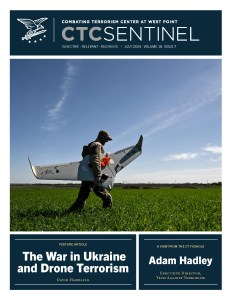From the Editors
What are the impacts of the war in Ukraine on the threat of drone terrorism? That is the question David Hambling addresses in our feature article this month. Specifically, he examines three of the most relevant drone types to counterterrorism—DJI Mavics, FPV racing drones, and Shahed-type long-range attack drones—whose “affordability, accessibility, and adaptability enable precision strikes, bypass traditional defenses, and democratize air power for state and non-state actors alike.” In outlining possible defenses against drones, Hambling warns that while “there is currently no good single solution to the drone threat on the battlefield … defense is even more challenging outside of a war situation where readiness is lower, and rules may not allow defenders to engage drones.”
Our interview this month is with Adam Hadley, executive director of Tech Against Terrorism, which works to disrupt terrorist activity online. He explains that despite the growth of AI, most terrorist activity online today is still “quite rudimentary. It’s sharing content, it’s having conversation, it’s looking for bomb-making materials, it’s doing basic ISR work.” Nevertheless, he cautions that “unless we vastly accelerate the pace of our own understanding” of AI tools, “hostile nation-states will overtake us, and the more sophisticated terrorist organizations will as well. It is a race against time.”
Nicolas Stockhammer, in analyzing six (foiled or executed) lone actor jihadi attacks in Europe since October 7, 2023, finds “a recurring radicalization pattern involving emotionally vulnerable, digitally native individuals exposed to algorithm-driven Islamist content in social media, but predominantly on TikTok.” He writes that a convergence of radical content and the normalization of extremist narratives online, particularly targeted toward susceptible youth, “has transformed contemporary jihadism into a fluid, networked, and increasingly aestheticized movement—one capable of inspiring violence not through clandestine training camps, but through swipeable videos, viral slogans, and online ‘tribalism.’”
The pace of U.S. airstrikes against jihadi groups in Somalia has increased significantly in 2025. David Sterman examines “the rationales that have been cited to explain the increase, and what existing evidence reveals about the potential threat to the U.S. homeland.”
Don Rassler and Kristina Hummel, Editors-in-Chief
 Skip to content
Skip to content

